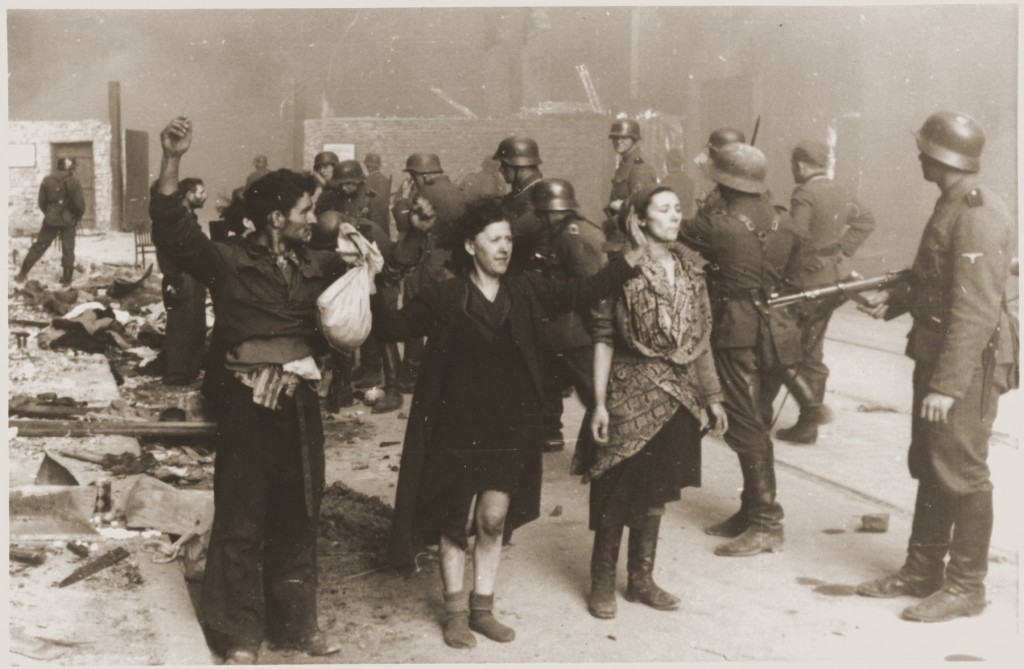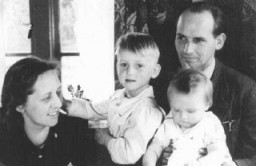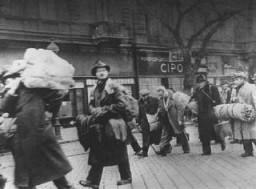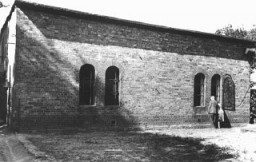
Jewish Resistance
Nazi-sponsored persecution and mass murder fueled resistance to the Germans in the Third Reich itself and throughout occupied Europe. Although Jews were the Nazis' primary victims, they too resisted Nazi oppression in a variety of ways, both collectively and as individuals.
Organized armed resistance was the most forceful form of Jewish opposition to Nazi policies in German-occupied Europe. Jewish civilians offered armed resistance in over 100 ghettos in occupied Poland and the Soviet Union.
In April-May 1943, Jews in the Warsaw ghetto rose in armed revolt after rumors that the Germans would deport the remaining ghetto inhabitants to the Treblinka killing center. As German SS and police units entered the ghetto, members of the Jewish Fighting Organization (Zydowska Organizacja Bojowa; ZOB) and other Jewish groups attacked German tanks with Molotov cocktails, hand grenades, and a handful of small arms. Although the Germans, shocked by the ferocity of resistance, were able to end the major fighting within a few days, it took the vastly superior German forces nearly a month before they were able to completely pacify the ghetto and deport virtually all of the remaining inhabitants. For months after the end of the Warsaw ghetto uprising, individual Jewish resisters continued to hide in the ruins of the ghetto, which SS and police units patrolled to prevent attacks on German personnel.
During the same year, ghetto inhabitants rose against the Germans in Vilna (Vilnius), Bialystok, and a number of other ghettos. Many ghetto fighters took up arms in the knowledge that the majority of ghetto inhabitants had already been deported to the killing centers; and also in the knowledge that their resistance even now could not save from destruction the remaining Jews who could not fight. But they fought for the sake of Jewish honor and to avenge the slaughter of so many Jews.
Thousands of young Jews resisted by escaping from the ghettos into the forests. There they joined Soviet partisan units or formed separate partisan units to harass the German occupiers.
Although many Jewish council (Judenrat) members cooperated under compulsion with the Germans until they themselves were deported, some, such as Jewish council chairman Moshe Jaffe in Minsk, resisted by refusing to comply when the Germans ordered him to hand over Jews for deportation in July 1942.
Jewish prisoners rose against their guards at three killing centers. At Treblinka in August 1943 and Sobibor in October 1943, prisoners armed with stolen weapons attacked the SS staff and the Trawniki-trained auxiliary guards. The Germans and their auxiliaries killed most of the rebels, either during the uprising or later, after hunting down those who escaped. Several dozen prisoners eluded their pursuers and survived the war, however. In October 1944, at Auschwitz-Birkenau, members of the Jewish Special Detachment (Sonderkommando) mutinied against the SS guards. Nearly 250 died during the fighting; the SS guards shot another 200 after the mutiny was suppressed. Several days later, the SS identified five women, four of them Jewish, who had been involved in supplying the members of the Sonderkommando with explosives to blow up a crematorium. All five women were killed.
In many countries occupied by or allied with the Germans, Jewish resistance often took the form of aid and rescue. Jewish authorities in Palestine sent clandestine parachutists such as Hannah Szenes into Hungary and Slovakia in 1944 to give whatever help they could to Jews in hiding. In France, various elements of the Jewish underground consolidated to form different resistance groups, including the Armée Juive (Jewish Army) which operated in the south of France. Many Jews fought as members of national resistance movements in Belgium, France, Italy, Poland, Yugoslavia, Greece, and Slovakia.
Jews in the ghettos and camps also responded to Nazi oppression with various forms of spiritual resistance. They made conscious attempts to preserve the history and communal life of the Jewish people despite Nazi efforts to eradicate the Jews from human memory. These efforts included: creating Jewish cultural institutions, continuing to observe religious holidays and rituals, providing clandestine education, publishing underground newspapers, and collecting and hiding documentation, as in the case of the Oneg Shabbat archive in Warsaw that would tell the story of the Jews in the Warsaw ghetto, despite its destruction in 1943.
Series: Rescue and Resistance during the Holocaust
Critical Thinking Questions
- Resistance comes in many forms, both violent and non-violent. Consider the many factors which may lead an individual or group to resist an oppressive regime. Investigate these factors in other periods of persecution.
- What risks might a group or individual face when resisting the actions of government or society?
Further Reading
Gutman, Israel. The Jews of Warsaw, 1939-1943: Ghetto, Underground, Revolt. Bloomington: Indiana University Press, 1982.
Krakowski, Shmuel. The War of the Doomed: Jewish Armed Resistance in Poland, 1942-1944. New York: Holmes and Meier, 1984.
Rudavsky, Joseph. To Live With Hope, To Die With Dignity: Spiritual Resistance in the Ghettos and Camps. Northvale, NJ: Jason Aronson, 1997.
Tec, Nechama. Defiance: The Bielski Partisans. New York: Oxford University Press, 1993.
Ainsztein, Reuben. Jewish Resistance in Nazi-occupied Eastern Europe: With a Historial Survey of the Jew as Fighter and Soldier in the Diaspora. New York: Barnes & Noble Books, 1974.
Glass, James M. Jewish Resistance during the Holocaust: Moral Uses of Violence and Will. Houndmills, Basingstoke, Hampshire: Palgrave Macmillan, 2004.
Grubsztein, Meir, editor. Jewish Resistance during the Holocaust: Proceedings of the Conference on Manifestations of Jewish Resistance, Jerusalem, April 7-11, 1968. Jerusalem: Yad Vashem, 1971.









